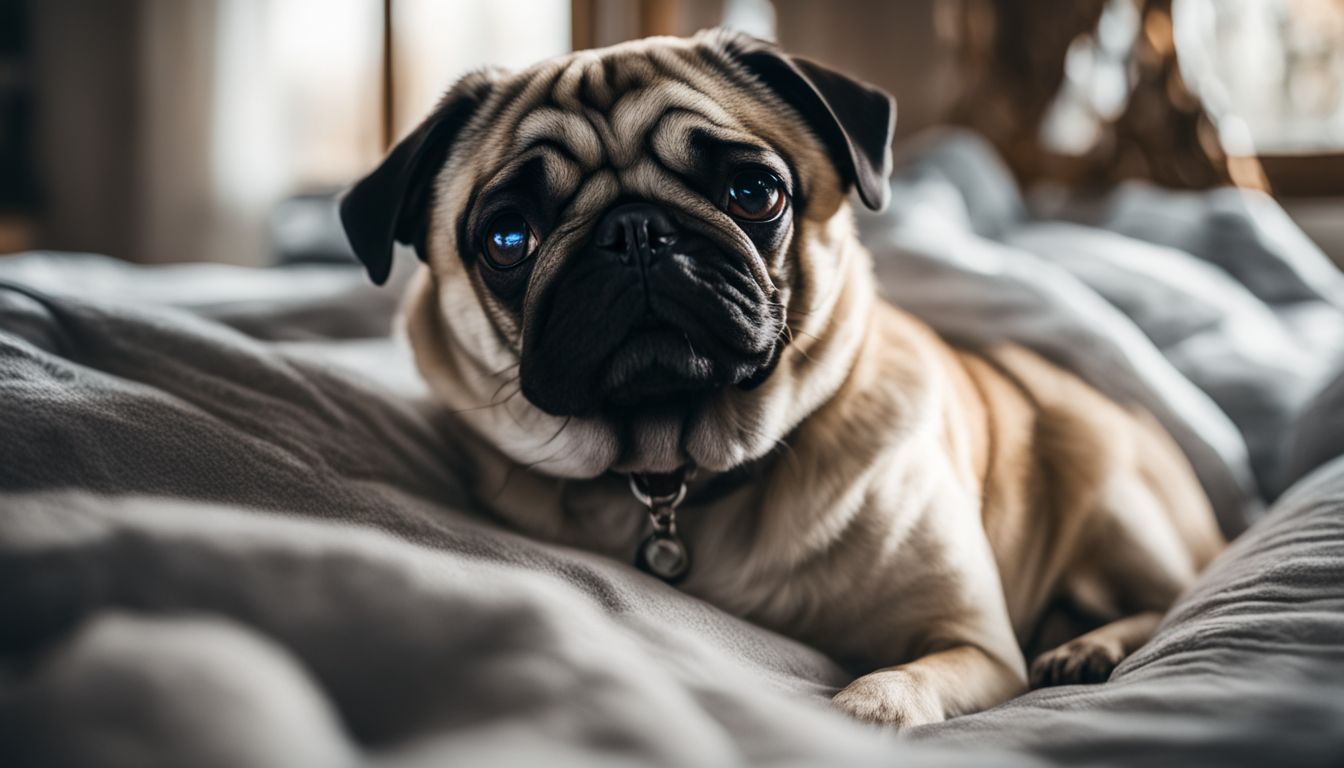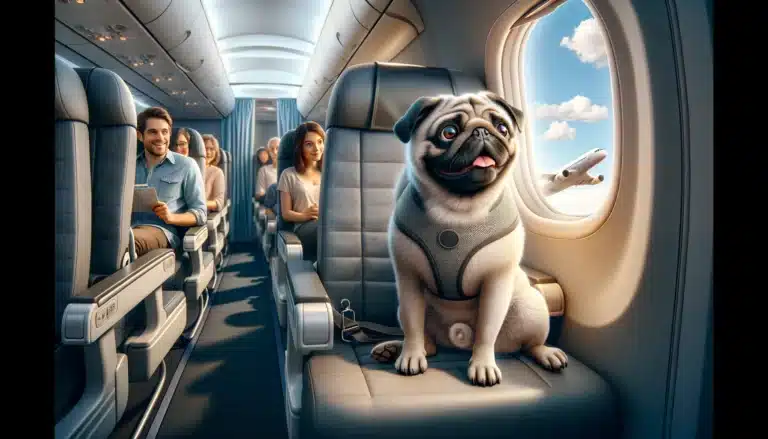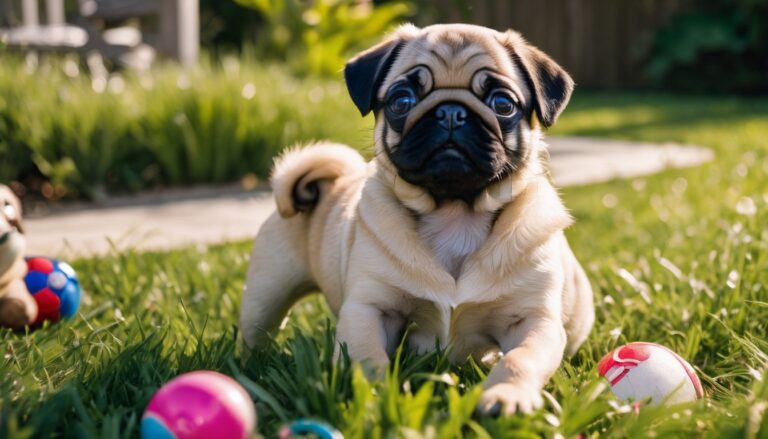Can Pugs Sleep Alone? Understanding The Sleep Habits And Needs Of Pugs
Can Pugs Sleep Alone?
Have you ever caught yourself pausing mid-day, the silence of an empty house pressing in, and wondering if your pug can truly sleep soundly when you’re not around? Trust us, as devoted pug aficionados who cherish these little bundles of love, we’ve pondered this question time and again.
These fur babies require a good 10 to 14 hours of Z’s daily, but how do they fare when their human isn’t there to cuddle up with? We took it upon ourselves to explore every facet of a pug’s dreamland—from their endearing sleeping quirks to conquering that pesky separation anxiety.
Note: Bruce Lee sleeps with us every night, and we wouldn’t change that for anything. He makes a heck of a heater on cold Michigan nights as well.
Sharing these nuggets of wisdom warms our hearts because we get it – there’s nothing like the peace of mind that comes from knowing your four-legged companion is content–and comfortably snoring–whether you’re nearby or away.
So stick with us; by giving your precious pup the gift of quality rest, you’re setting up your home for all-around joy and contentment!
Key Takeaways
- Pugs need an average of 10 to 14 hours of sleep daily, and making them comfortable is key to managing their sleep habits. Providing a cozy bed and blankets can help create a safe space for your pug to rest alone.
- Separation anxiety can affect how well pugs sleep when left by themselves. Using positive reinforcement, establishing a routine, and providing familiar comforts can ease anxiety and encourage independent sleeping behaviors in pugs.
- Excessive sleeping or changes in a pug’s normal rest patterns could indicate underlying health issues that require attention. Monitoring their sleep quality and consulting with a vet if there are concerns is essential for your pet’s well-being.
- Older dogs may need more rest than younger ones, so be mindful of increased sleep needs as your pug ages. Adequate exercise during the day also contributes to healthier sleep routines for this breed.
- Consistency is vital when training your pug to feel secure sleeping alone—stick with set mealtimes, play sessions, and bedtime to establish predictability in their lives. This structure helps reduce stress for both the dog and owner over time.
Can Pugs Be Left Alone for Extended Periods of Time?

Pugs, with their endearing eyes and affectionate nature, often form strong bonds with their owners. However, understanding their capacity for solitude is crucial before considering whether to leave them alone for extended periods.
Considerations to Keep in Mind
As we think about leaving our pugs alone, it’s crucial to weigh their need for companionship against our schedules. These pups may get anxious if they don’t feel the safety of their owners nearby, especially during the night.
This breed thrives on attention and interaction, so long hours of solitude can be tough on them.
Before deciding how much alone time is okay for our furry friends, let’s consider their age too. Younger puppies and older dogs might need more frequent check-ins due to different sleep requirements or health concerns.
Their comfort should always be at the forefront of our planning since a well-rested pug is a happy one!
Pugs’ Tendency to Sleep
Pugs love their sleep, and that’s perfectly normal for this breed. Our little companions may spend up to 14 hours a day snoozing, which is just a bit of what makes them so endearing.
During these long stretches of slumber, they recharge and dream, sometimes even wiggling their paws or making quirky sounds while deep in the REM stage of sleep. We adore watching them curled up cozy and content; it reminds us how much they rely on regular rest for their health and happiness.
The tendency for pugs to prefer snuggling under covers isn’t just about being cute – it’s about seeking comfort and warmth too. Their fondness for a good nap means we have to provide them with a comfortable space where they can rest undisturbed.
A memory foam mattress or plush dog bed often becomes their favorite spot in the house! And now that we’re tuned into our pug’s sleeping habits let’s explore how co-sleeping might benefit our snuggly friends.
The Benefits of Co-Sleeping with Your Pug

Co-sleeping with your pug can enhance the unique bond you share, offering mutual comfort and alleviating anxiety that may arise when they’re left alone. This shared experience not only strengthens your connection but also contributes to a sense of security for both you and your furry companion.
Bonding with Your Pug
Sharing your bed with your pug can deepen the bond between you and your furry friend. These little dogs often seek the closeness of their owners for security and warmth, especially during the night.
Creating a sleeping space where they feel safe not only fosters trust but also offers them comfort, mirroring the care we provide to our loved ones.
Having your pug sleep close by may reduce their anxiety, particularly if they’re prone to feeling stressed when alone. This practice allows us both to enjoy a restful night’s sleep knowing that we are there for each other.
Our presence reassures them just as much as their steady breathing soothes us, creating a peaceful environment for everyone involved.
Warmth and Comfort for Your Pug
Creating a cozy sleeping environment is essential for our pugs. These little companions often seek the softest, warmest spots in the house to curl up and rest. To enhance their comfort, especially during colder nights, we can provide them with plush dog beds that mimic the warmth and closeness they would experience snuggling next to us.
Our furry friends may even prefer to burrow under blankets; offering them a blanket of their own gives that sense of security and warmth they love.
Ensuring our pugs are comfortable at night isn’t just about indulgence; it’s also about health. Pugs thrive on feeling safe and secure, so a well-chosen bed can reduce anxiety levels significantly.
It’s also key for supporting their muscular-skeletal health as they snooze away — remember, an adult pug needs around 14 hours of sleep daily! Therefore, investing in a supportive yet comfy bed will pay off by nurturing both their physical well-being and emotional contentment as they drift into dreamland each night.
Reducing Anxiety for Your Pug
Reducing anxiety in our pugs is essential for their health and happiness. To help them feel more at ease, we can create a peaceful sleeping environment with familiar blankets or toys that carry the comforting scent of home.
Pugs often seek the safety of snuggling close to us; consider allowing your furry friend to sleep near you if they seem anxious alone. A cozy bed placed in your bedroom might be just what your pug needs to relax through the night.
Pugs thrive on routine and predictability, so sticking to a regular bedtime schedule will signal that it’s time to wind down and get ready for sleep. We also need to ensure they’re getting enough playtime and exercise during the day which naturally leads to deeper, more restful slumber.
By addressing these simple but impactful factors, we support our beloved pugs in overcoming anxiety and ensuring they enjoy their beauty rest each night.
Factors that Influence Pug’s Sleeping Habits
Understanding the nuances of a pug’s sleep is essential for their well-being. There are multiple factors that can significantly affect how your furry friend slumbers, shaping their overall sleep quality and health.
Let’s dive into what influences a pug’s restful nights, beyond the basic need for a cozy spot to curl up in.
Temperature
Pugs feel the cold more than some other breeds due to their short coats. They often seek out cozy spots to burrow into for warmth, so it’s essential we provide them with a comfortable sleeping environment that isn’t too hot or too chilly.
Many pugs love snuggling under blankets; this not only keeps them warm but also gives them a sense of security and comfort while they sleep.
Ensuring the right temperature is crucial as both extremes can affect your pug’s health. Overheating can lead to breathing difficulties, especially for brachycephalic dogs like pugs, who already face challenges with respiration.
On the flip side, if they’re too cold during rest, pugs may struggle to reach that deep sleep necessary for their well-being. Next up: Anxiety plays another significant role in how well our furry companions drift off at night.
Anxiety
Our pug pals can get anxious when they’re left alone. This worry often comes from their deep bond with us and their need for companionship. If we notice our dog pacing, whining, or showing other signs of distress, these could be clues that they’re feeling separation anxiety.
Short periods apart are generally okay, but longer stretches without company can stress them out.
We should create a cozy space for our pugs to feel safe in when we have to step out. Special toys that keep them busy or a piece of clothing with our scent might comfort them. It’s also wise to leave some background noise on like a TV or radio; it provides the illusion of company and eases the silence that may heighten their unease.
By considering these tips, we help maintain their emotional well-being until we return home to those eagerly awaiting snuggles!
Comfort
Ensuring our pugs are comfortable at night is just as crucial as finding the perfect spot for ourselves to catch some z’s. Pugs have a distinct preference for snoozing under covers, where they can bask in warmth and coziness.
This love for snug spots means providing them with a bed that allows burrowing or draping blankets might just be the secret to helping them drift into their peaceful 14-hour slumber.
Soft beds and favorite blankets not only mimic this natural desire but also support their joints and muscles while they rest. As we tuck them in, it’s reassuring to know that the right sleeping setup could alleviate any hints of separation anxiety, making silent nights all the more serene for our little companions.
Understanding Pug’s Separation Anxiety
Understanding a pug’s separation anxiety is crucial for their well-being; delve into strategies and insights that can help your furry companion feel secure even when you’re not around.
Coping Strategies for Pugs Left Alone
Leaving our pug home alone can be tough for both of us. They often feel more secure when we’re around, but sometimes it’s necessary for them to spend time by themselves. Here are some strategies that can help our pugs cope with being alone:
- Create a safe and cozy space for your pug to rest in your absence. Fill it with their favorite blanket and toys so they have familiar comforts.
- Play calming music or leave the television on at a low volume. Sounds from these can provide a sense of company and prevent them from feeling too isolated.
- Use interactive toys that challenge them and keep their minds active while you’re away. Treat-dispensing puzzle toys can be especially effective.
- Before leaving, give your pug plenty of exercises. A good play session can tire them out and encourage them to sleep while you’re gone.
- Practice short departures to build up your pug’s tolerance for being alone gradually. Start with just a few minutes and then slowly increase the time you’re away.
- Consider using pet cameras to watch over and even talk to your pug remotely. This technology helps ease the worry as you check in on them throughout the day.
- If separation anxiety is severe, consult with a vet about potential treatments or behavioral training methods that may soothe your pug’s nerves.
- Think about hiring a pet sitter or using doggy daycare services if you’ll be gone for extended periods regularly. This way, socialization continues, and loneliness is kept at bay.
What is Normal for Pug’s Sleeping Habits
Understanding what’s normal for a pug’s sleeping routine is key to ensuring their health and happiness. Pugs typically enjoy lengthy snoozes, but recognizing the balance between expected slumber and excessive sleepiness can help you spot potential issues early on.
Let’s dive deeper into their world of dreams and discover how much shut-eye your furry companion truly needs.
Average Hours of Sleep for Pugs
Pugs, with their snugly faces and affectionate personalities, need plenty of rest to stay healthy and happy. They typically clock in between 10 and 14 hours of sleep each day, surpassing the average human’s sleep cycle.
Newborn pugs pack in even more Z’s—they can spend up to a staggering 22 hours asleep as they grow! With older age or if health issues arise, these adorable furballs may drift off for longer periods.
As we keep an eye on our pug’s sleeping patterns, it’s important to be aware that changes could signal something needs our attention. If you notice your little friend snuggling under covers more often or dozing off for lengthy spans, make sure they’re comfortable and that no underlying problems are causing excess slumber.
Now let’s delve into what might cause trouble when your pug tries to catch some shut-eye in the next section about signs of trouble sleeping.
Signs of Trouble Sleeping
If your pug is tossing and turning or seems restless at night, it could be a sign they’re having trouble sleeping. Frequent waking or changes in their sleep patterns often indicate discomfort or anxiety.
They might whine, pace around the bed, or have difficulty settling down for a good snooze.
Pay attention if your buddy snores louder than usual or gasps for air – these could be symptoms of sleep apnea, a condition not uncommon in flat-faced breeds like ours. Your sweet furball should ideally clock in up to 14 hours of slumber; less than that and they might not be getting the rest they need.
Excessive daytime napping beyond their normal hours can also signal underlying health issues requiring veterinary attention. Keep an eye on their energy levels during the day—if they seem lethargic despite enough shut-eye, it’s time to take action for your pug’s well-being.
Reasons for Excessive Sleeping
Noticing signs of trouble in your pug’s sleeping patterns could point to several underlying causes for the need for extra shut-eye. Pugs may sleep more than usual due to their age, as older dogs tend to require more rest.
But there’s more we should watch out for. Health issues commonly trigger excessive sleepiness, so keep an eye on any changes in behavior that stray from normal pug sleeping habits.
Sometimes a change in diet or lack of adequate nutrition can lead to increased drowsiness, indicating your furry friend isn’t getting what they need to stay alert and active. Let’s ensure our pugs’ food bowls are filled with nutritious meals that give them the energy they love.
Also, if your companion seems lethargic even after a long nap, it might be worth discussing with a vet since health concerns like thyroid problems could be at play here. As responsible owners, we must pay close attention to our beloved pets’ snooze cycles because their well-being is always our top priority.
Training Your Pug to Sleep Separately
Training your Pug to sleep separately can be a gentle process that enhances their independence and comfort during the night; continue reading to learn how we can achieve this milestone together.
Providing a Comfortable Dog Bed
We know our pugs cherish their sleep, often dozing for up to 14 hours a day. To ensure they get the restful slumber they need, a comfy dog bed is essential. Look for beds with soft yet supportive cushions that will cradle their little bodies.
Since pugs love warmth and might burrow under covers, consider beds with raised edges or hood-like structures where they can snuggle in cozily.
Selecting the right size bed is crucial — it should be roomy enough for your pug to stretch out but cozy enough to give them a sense of security. Some beds come with extra features like orthopedic support which can be especially beneficial for older dogs who may need more joint care.
A comfortable dog bed not only helps your pet drift into deep slow-wave and rapid eye movement sleep but also gives them a personal space where they feel safe even when you’re not around.
Using Positive Reinforcement
Once you’ve selected the perfect dog bed for your pug, it’s time to focus on encouraging them to use it. Positive reinforcement is a powerful tool in training dogs, and it works wonders with your little buddy.
Every time they opt for their own comfy spot instead of yours, reward them with treats or enthusiastic praise. Make sure these rewards are immediate so that your pug associates sleeping in their own bed with positive outcomes.
Incorporate this method into your daily routine by guiding them to their bed at sleep times and voicing cheerful affirmations as they settle down. They’ll soon learn that snoozing in their special space gets them extra love and maybe even a yummy snack! Your consistency will pay off, creating a peaceful night’s rest for both of you without resorting to using tranquillizers or antidepressants for anxiety issues some pugs face when left alone overnight.
Keep up the encouragement and watch as your pug grows more independent, comfortable, and secure in their very own sleep haven.
Establishing a Routine
Establishing a routine for your Pug’s sleep schedule is as essential as their diet. Start by setting specific times for meals, play, and bedtime to create consistency. This regularity helps cue your furry friend on when it’s time to wind down and rest.
Always ensure that the sleeping area you’ve chosen, whether it’s a cozy crate or a plush dog bed, is inviting and comfortable. A familiar space with their favorite blanket can make all the difference in easing into solo slumbers.
Stick to this routine every day, including weekends. Your Pug will learn what to expect and when which can significantly decrease anxiety during nighttime. Keep evenings calm without overstimulation; this signals that it’s time for those 10 to 14 hours of needed rest.
With patience and persistence, our loyal companions will adapt to sleeping alone while still feeling safe and secure in their home environment.
Being Patient
After setting a routine for your pug’s sleep schedule, the next step requires patience. Training takes time, and every pup responds differently. Some pugs may quickly adapt to sleeping alone while others might take longer to feel secure without you.
Stay consistent with the bedtime habits you’ve introduced and give your furry friend the chance to get used to their new environment.
We understand it can be tough not to cave when those big eyes are pleading for just one more night together. However, hold firm in your training efforts. Your patience will pay off as your pug learns independence and comfort in their own space, leading to better sleep for both of you in the long run.
Just like us, our little companions need time to adjust; they’ll get there with love and persistence from their favorite humans – that’s us!
Can Pugs Sleep Alone Conclusion
In summary, Pugs have unique sleep needs that we as owners must respect and understand. Training them to rest alone can benefit both their independence and our lifestyle. Providing a snug bed and maintaining a routine will help our furry friends feel secure.
Let’s ensure our pugs get the right amount of zzz’s for their health and happiness. Remember, each Pug is special; staying attuned to their sleeping patterns is key!
Can Pugs Sleep Alone FAQs
1. Can pugs sleep alone through the night?
Yes, pugs can indeed sleep alone, though as puppies they may need time to adjust. Crate training can help a pug feel secure and comfortable when sleeping by themselves.
2. Why does my pug seem restless at night?
Restlessness in your pug could be due to various reasons including lack of exercise during the day or even separation anxiety. Ensuring they have a cozy bed and a regular sleep routine might ease their restlessness.
3. Do certain health issues cause insomnia in pugs?
Health issues like respiratory problems due to their nose structure, or conditions that may cause discomfort such as arthritis, can lead to insomnia in pugs. Consult with your vet if you notice persistent sleep disturbances.
4. How much sleep do young pugs usually need?
Young puppies, including baby pugs, generally require more sleep than adult dogs—upwards of 18 hours per day—to support their growth and development.
5. What should I do if my older pug is experiencing increased lethargy during the day?
If an older pug exhibits lethargy it’s wise to talk with your vet since it could be linked to various causes like vitamin deficiencies or the need for medications such as Buspirone under medical advice.







